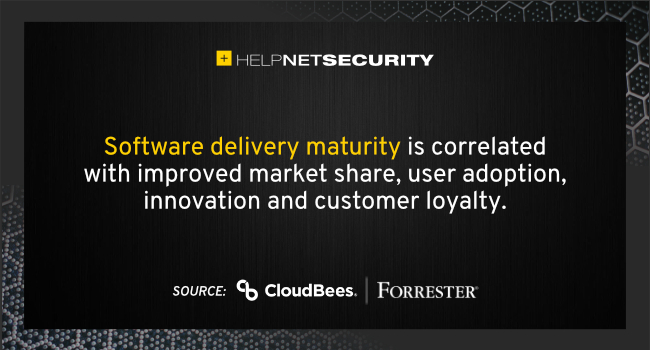Software delivery maturity generating business benefits
Organizations with a high level of software delivery maturity are three times more likely to grow at 15 percent or more annually, according to Forrester Consulting.

Conversely, those not modernizing their software delivery processes face increasing roadblocks that limit growth, slow DevOps transformations and expose security and risk vulnerabilities.
“The organizations that unravel the complexities of the software delivery process exceed business objectives and grow revenue faster than those that do not,” said Stephen DeWitt, CEO at CloudBees.
“Those that don’t, face issues with collaboration and communication across their organizations which can lead to siloed development, delivery bottlenecks and ultimately, customer dissatisfaction. It’s like driving on a dirt road instead of a four-lane highway to achieve your goals. You can get where you’re going faster and with fewer potholes along the way.”
According to the study, “Organizations that pair delivery automation capabilities with effective collaboration practices see more successful digital transformations and exceed business expectations at a higher rate than those that cannot. Software delivery maturity is correlated with improved market share, user adoption, innovation and customer loyalty.”
Software delivery maturity correlated with business growth
Organizations that reach high levels of software delivery maturity also generate continuous business benefits. According to the study, they are more likely to:
- Succeed with their DevOps transformations: High-maturity respondents are more than five times as likely to say their DevOps transformation is exceeding business expectations (35 percent to six percent).
- Grow revenue faster: High-maturity organizations are more likely to grow revenue at a higher rate than their less mature peers — they are almost three times as likely to be growing at 15 percent or more year over year.
- Adapt to changing market conditions: High-maturity respondents in the survey are nearly twice as likely than low-maturity respondents to say their organizations responded to the pandemic better than their peers (49 percent vs. 27 percent).
Although there is progress, perfection remains out of reach for most
- Not quite continuous deployment: Just 27 percent of respondents said that they practice continuous deployment with automation from commit through testing, build/integration, package and final release.
- Risky business: Only 25 percent rate their governance, risk and compliance (GRC) capabilities for software delivery as very mature, with 40 percent saying they are not mature.
- Status unknown: Fewer than three in 10 high-maturity respondents say they have all the information they need in a single study to understand software release status, dipping to a woeful two percent for low maturity.
- Finding bottlenecks: Fewer than half of high-maturity respondents, and only one in 10 low-maturity, can pinpoint the bottlenecks in their delivery processes in order to fix them.